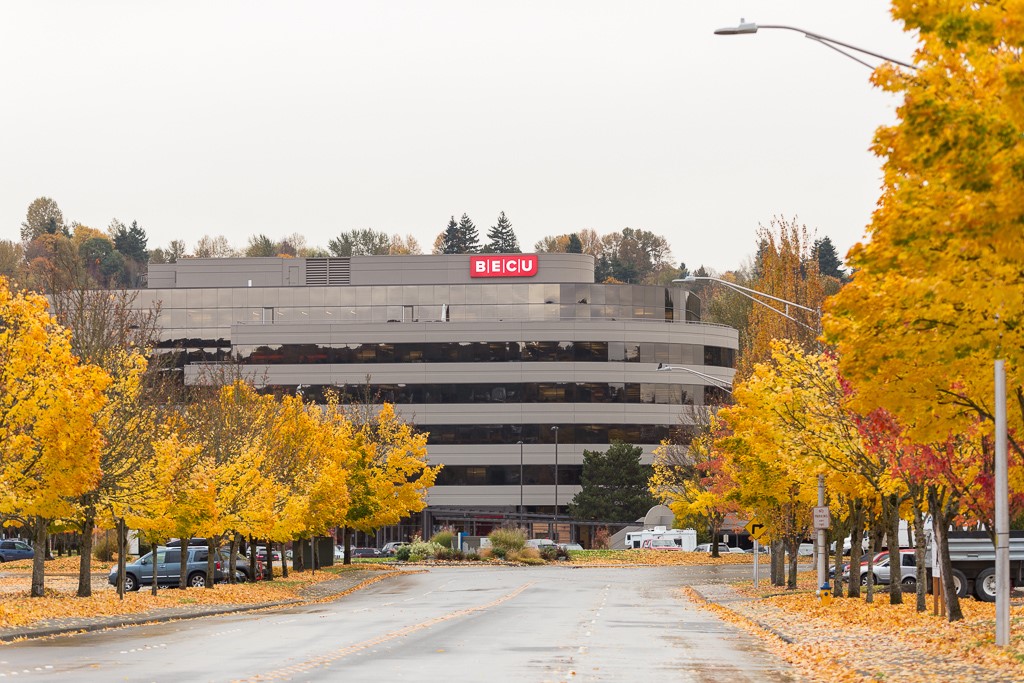FORT WORTH, Texas – Top to bottom, American Airlines Federal Credit Union's year-old headquarters is a visible sign of its commitment to its sponsor company, American Airlines, and the aviation industry. The two-section 110,000 square-foot facility, designed by Corgan Associates, Inc., houses a staff of approximately 300. With its high streamlined roof, the limestone "great wall" of the credit union's headquarters serves as a backdrop to the sleek, aerodynamic metal and glass structure of the branch office situated directly in front. The 14,000 square-foot branch looks like a miniature airline hangar, with lots of windows and high ceilings. The interiors incorporate wing-like forms, sweeping curves, metal railings and metal wall panels to complement the exterior architecture and the credit union's aviation heritage. An eye-catching metal sign, shaped like the tail of a plane, flanks the reception desk in the lobby. The sign displays the credit union's vision statement and product announcements. "When I saw this on the original sketches," said John Tippets, the credit union's CEO, "it was just a sign. I didn't catch the architect's vision. It's really a piece of art, almost a sculpture." The focal element incorporating the airline history into the credit union facility is the large-scale model of a DC-3 that is suspended from the ceiling in the branch lobby. The DC-3 holds historical significance as it was first delivered to American Airlines in 1936, the same year the credit union was established. The building has no cafeteria. Instead, employees can enjoy sack lunches, or ice cream and snacks from machines, in the "vendateria" or on the adjacent patio. An underground tunnel gives employees a covered walkway access to other dining options on bad weather days. "The tunnel is somewhat of an umbilical cord. I didn't want to support a cafeteria. I didn't want to pay for covered parking, and I don't like the aesthetics of covered parking," Tippets explained. A hallway with a lengthy lighted ceiling "ripple" provides an interesting transition between the branch and the credit union's four-story, 96,000-square-foot headquarters. In the headquarters building, most closed offices are situated on north/south walls. Banks of windows are on east/west windows to maximize the natural light that is shared by employees in cubicles. Wall art depicts beautiful places in America (American Airlines destinations), but it is not framed travel posters, Tippets points out. He handpicked most of them, some to reflect places he's visited, others to honor employee places of origin. "There are certain places I've been that I want these folks to know about. If we could pick up the aviation theme, we did that, too," said Tippets. Conference rooms, such as the Thunderbirds and Anchors Away Rooms, reflect the military aviation backgrounds many members and employees have. The Dooley Room, or boardroom, is named and decorated for a 63-year member of the credit union. No one knows for sure when Dooley was first elected to the credit union board of directors, but he has had a long, continuous tenure. The room has pictures of the Chrysler Building and the Empire State Building in honor of this New York native. Ceiling lighting and alignment of windows remind one of an airplane cabin interior. A unique v-shaped table allows board members to hold eye-to-eye conversations. A commissioned painting, "Nature's Flight Academy," hangs outside the boardroom. It is a scene of two adult eagles coaching a fledgling to fly. Not surprisingly, the building carries distinct tributes to the victims of the Sept. 11 terrorist attacks, an event that impacted the entire membership of the credit union. One wall displays plaques dedicated to two AA employees who served as credit union coordinators and lost their lives in the 9/11 plane crashes. A commissioned painting entitled "Out of the Storm" hangs in the west lobby. The picture depicts an eagle soaring out of and above the dark clouds, symbolic of the airline's and the country's flight out of the darkness of the 9/11 tragedy. Even the credit union real estate holds aviation history. The land was once a part of Greater Southwest International Airport, the small Fort Worth airport that entered the market for just 11 years to compete with Dallas Love Field, prior to construction of Dallas/Fort Worth International Airport in the late 1960s. -
© Touchpoint Markets, All Rights Reserved. Request academic re-use from www.copyright.com. All other uses, submit a request to [email protected]. For more inforrmation visit Asset & Logo Licensing.






